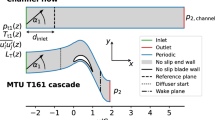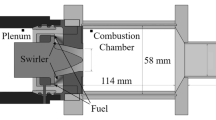Abstract
The flow and acoustic fields of subsonic turbulent hot jets exhausting from three divergent nozzles at a Mach number M=0.12 based on the nozzle exit velocity are conducted using a hybrid CFD-CAA method. The flow field is computed by highly resolved large-eddy simulations (LES) and the acoustic field is computed by solving the acoustic perturbation equations (APE) whose acoustic source terms are determined by the LES. The LES of the computational domain includes the interior of the nozzle geometry. Synthetic turbulence is prescribed at the inlet of the nozzle to mimic the exit conditions downstream of the last turbine stage. The LES is based on hierarchically refined Cartesian meshes, where the nozzle wall boundaries are resolved by a conservative cut-cell method. The APE solution is determined on a block structured mesh. Three nozzle geometries of increasing complexity are considered, i.e., the flow and acoustic fields of a clean geometry without any built-in components, a nozzle with a centerbody, and a nozzle with a centerbody plus struts are computed. Spectral distributions of the LES based turbulent fluctuated quantities inside the nozzle and further downstream are analyzed in detail. The noise sources in the near field are noticeably influenced by the nozzle built-in components. The centerbody nozzle increases the overall sound pressure level (OASPL) in the near field with respect to the clean nozzle and the centerbody-plus-strut nozzle reduces it compared to the centerbody nozzle due to the increased turbulent mixing. The centerbody perturbed nozzle configurations generate a remarkable spectral peak at S t=0.56 which also occurs in the APE findings in the near field region. This tone is generated by large scale vortical structures shed from the centerbody. The analysis of the individual noise sources shows that the entropy term possesses the highest acoustic contribution in the sideline direction whereas the vortex sound source dominates the downstream acoustics.


























Similar content being viewed by others
References
Tam, C. K. W.: Computational aeroacoustics-issues and methods. AIAA J. 33 (10), 1788–1796 (1995)
Speth, R. L., Gaitonde, D. V.: Nozzle-exit boundary-layer effects on a controlled supersonic jet. AIAA J. 53(7), 2027–2039 (2015)
Bogey, C., Bailly, C.: Influence of nozzle-exit boundary-layer conditions on the flow and acoustic fields of initially laminar jets. J. Fluid Mech. 663, 507–538 (2010)
Bogey, C., Marsden, O.: Identification of the effects of the nozzle-exit boundary-layer thickness and its corresponding reynolds number in initially highly disturbed subsonic jets. Phys Fluids (1994-present) 25(5), 055106 (2013)
Papamoschou, D.: Fan flow deflection in simulated turbofan exhaust. AIAA J. 44(12), 3088–3097 (2006)
Johnson, A. D., Xiong, J., Rostamimonjezi, S., Liu, F., Papamoschou, D.: Aerodynamic and acoustic optimization for fan flow deflection. AIAA Paper, 2011–1156 (2011)
Papamoschou, D., Shupe, R. S.: Effect of nozzle geometry on jet noise reduction using fan flow deflectors. AIAA Paper, 2006–2707 (2006)
Henderson, B., Norum, T., Bridges, J.: An MDOE assessment of nozzle vanes for high bypass ratio jet noise reduction. AIAA Paper, 2006–2543 (2006)
Brown, C., Bridges, J., Henderson, B.: Offset stream technology test–summary of results. AIAA Paper, 2007–3664 (2007)
Dippold, V. F., Foster, L. E., Wiese, M. R.: Computational analyses of offset-stream nozzles for noise reduction. J. Propuls. Power 25(1), 204–217 (2009)
Saiyed, N. H., Mikkelsen, K. L., Bridges, J.: Acoustics and thrust of quiet separate-flow high-bypass-ratio nozzles. AIAA J. 41(3), 372–378 (2003)
Viswanathan, K., Spalart, P. R., Czech, M. J., Garbaruk, A., Shur, M.: Tailored nozzles for jet plume control and noise reduction. AIAA J. 50(10), 2115–2134 (2012)
Bridges, J.: Broadband shock noise in internally-mixed dual-stream jets. AIAA Paper, 2009–3210 (2009)
Brés, G. A., Bose, S. T., Ham, F. E., Lele, S. K.: Unstructured large eddy simulations for nozzle interior flow modeling and jet noise predictions. AIAA Paper, 2014–2601 (2014)
Freund, J. B.: Noise sources in a low-Reynolds-number turbulent jet at Mach 0.9. J. Fluid Mech. 438, 277–305 (2001)
Bogey, C., Bailly, C., Juvé, D.: Noise investigation of a high subsonic, moderate Reynolds number jet using a compressible large eddy simulation. Theor. Comput. Fluid Dyn. 16(4), 273–297 (2003)
Koh, S. R., Schröder, W., Meinke, M.: Turbulence and heat excited noise sources in single and coaxial jets. J. Sound Vib. 329(7), 786–803 (2010)
Boris, J. P., Grinstein, F. F., Oran, E. S., Kolbe, R. L.: New insights into large eddy simulation. Fluid Dyn. Res. 10(4-6), 199–228 (1992)
Alkishriwi, N., Meinke, M., Schröder, W.: Large-eddy simulation of streamwise-rotating turbulent channel flow. Comput. Fluids 37(7), 786–792 (2008)
Renze, P., Schröder, W., Meinke, M.: Large-eddy simulation of film cooling flows at density gradients. Int. J. Heat Fluid Flow 29(1), 18–34 (2008)
Meinke, M., Schröder, W., Krause, E., Rister, T.: A comparison of second-and sixth-order methods for large-eddy simulations. Comput. Fluids 31(4), 695–718 (2002)
Cetin, M. O., Pauz, V., Meinke, M., Schröder, W.: Computational analysis of nozzle geometry variations for subsonic turbulent jets. Comput. Fluids 136, 467–484 (2016)
Ewert, R., Schröder, W.: Acoustic perturbation equations based on flow decomposition via source filtering. J. Comput. Phys. 188(2), 365–398 (2003)
Koh, S. R., Geiser, G., Schröder, W.: Reformulation of acoustic entropy source terms. AIAA Paper, 2011–2927 (2011)
Markham, J. J.: Second-order acoustic fields: Streaming with viscosity and relaxation. Phys. Rev. 86(4), 497 (1952)
Lintermann, A., Schlimpert, S., Grimmen, J. H., Günther, C., Meinke, M., Schröder, W.: Massively parallel grid generation on HPC systems. Comput. Methods Appl. Mech. Eng. 277, 131–153 (2014)
Hartmann, D., Meinke, M., Schröder, W.: A strictly conservative cartesian cut-cell method for compressible viscous flows on adaptive grids. Comput. Methods Appl. Mech. Eng. 200(9), 1038–1052 (2011)
Schneiders, L., Günther, C., Meinke, M., Schröder, W.: An efficient conservative cut-cell method for rigid bodies interacting with viscous compressible flows. J. Comput. Phys. 311, 62–86 (2016)
Schneiders, L., Hartmann, D., Meinke, M., Schröder, W.: An accurate moving boundary formulation in cut-cell methods. J. Comput. Phys. 235, 786–809 (2013)
Johansson, S.: High order finite difference operators with the summation by parts property based on DRP schemes. tech. Rep., 2004–036 (2004)
Hu, F. Q., Hussaini, M. Y., Manthey, J. L.: Low-dissipation and low-dispersion Runge-Kutta schemes for computational acoustics. J. Comput. Phys. 124(1), 177–191 (1996)
Schröder, W., Ewert, R.: LES-CAA coupling. In: Large-eddy simulations for acoustics, Cambridge University Press (2005)
Ewert, R., Schröder, W.: On the simulation of trailing edge noise with a hybrid LES/APE method. J. Sound Vib. 270(3), 509–524 (2004)
Pardowitz, B., Tapken, U., Knobloch, K., Bake, F., Bouty, E., Davis, I., Bennett, G.: Core noise–identification of broadband noise sources of a turbo-shaft engine. AIAA Paper, 2014–3321 (2014)
Siewert, C., Kunnen, R. P. J., Schröder, W.: Collision rates of small ellipsoids settling in turbulence. J. Fluid Mech. 758, 686–701 (2014)
Kunnen, R. P. J., Siewert, C., Meinke, M., Schröder, W., Beheng, K. D.: Numerically determined geometric collision kernels in spatially evolving isotropic turbulence relevant for droplets in clouds. Atmos. Res. 127, 8–21 (2013)
Bogey, C., Bailly, C.: Computation of a high Reynolds number jet and its radiated noise using large eddy simulation based on explicit filtering. Comput. Fluids 35(10), 1344–1358 (2006)
Freund, J. B.: Proposed inflow/outflow boundary condition for direct computation of aerodynamic sound. AIAA J. 35(4), 740–742 (1997)
Tam, C. K. W., Webb, J. C.: Dispersion-relation-preserving finite difference schemes for computational acoustics. J. Comput. Phys. 107(2), 262–281 (1993)
Cetin, M. O., Koh, S. R., Meinke, M., Schröder, W.: Aeroacoustic analysis of a helicopter engine jet including a realistic nozzle geometry. AIAA Paper, 2015–2533 (2015)
Geiser, G., Koh, S., Schröder, W.: Analysis of acoustic source terms of a coaxial helium/air jet. AIAA Paper, 2011–2793 (2011)
Goldstein, M. E.: Aeroacoustics, vol. 1, p 87. McGraw-Hill Inc., New York (1976)
Viswanathan, K.: Aeroacoustics of hot jets. J. Fluid Mech. 516, 39–82 (2004)
Jülich Supercomputing Centre: JUQUEEN: IBM blue gene/Q supercomputer system at the jülich supercomputing centre. Journal of Large-Scale Research Facilities 1(A1), A1 (2015). doi:10.17815/jlsrf--1--18
Acknowledgments
The research was funded from the European Community’s Seventh Framework Programme (FP7, 2007-2013) PEOPLE program under the grant agreement No. FP7-290042 (COPAGT project). The authors gratefully thank the Gauss Centre for Supercomputing (GCS) for providing computing time for a GCS Large-Scale Project on the GCS share of the supercomputer JUQUEEN [44] at the Jülich Supercomputing Centre (JSC) and High Perfomance Computing Center Stuttgart (HLRS). GCS is the alliance of the three national supercomputing centres HLRS (Universität Stuttgart), JSC (Forschungszentrum Jülich), and LRZ (Bayerische Akademie der Wissenschaften) in Germany, funded by the German Federal Ministry of Education and Research (BMBF) and the German State Ministries for Research of Baden-Württemberg (MWK), Bayern (StMWFK) and Nordrhein-Westfalen (MIWF).
Author information
Authors and Affiliations
Corresponding author
Rights and permissions
About this article
Cite this article
Cetin, M.O., Koh, S.R., Meinke, M. et al. Numerical Analysis of the Impact of the Interior Nozzle Geometry on Low Mach Number Jet Acoustics. Flow Turbulence Combust 98, 417–443 (2017). https://doi.org/10.1007/s10494-016-9764-z
Received:
Accepted:
Published:
Issue Date:
DOI: https://doi.org/10.1007/s10494-016-9764-z




